Golden Gate Park
| Golden Gate Park | |
|---|---|
| Type | Urban Park |
| Location | San Francisco, California, United States |
| Coordinates | 37°46′11″N 122°28′37″W / 37.76972°N 122.47694°WCoordinates: 37°46′11″N 122°28′37″W / 37.76972°N 122.47694°W |
| Area | 1,017 acres (412 ha) |
| Created | 1870s |
| Visitors | 13 million[1] |
| Open | All year |
| Architect |
William Hammond Hall John McLaren Calvert Vaux |
| Architectural style | Olmsted, Vaux & Co.-influenced |
| NRHP Reference # | 04001137[2] |
| Added to NRHP | October 15, 2004 |
Golden Gate Park, located in San Francisco, California, United States, is a large urban park consisting of 1,017 acres (412 ha) of public grounds. It is administered by the San Francisco Recreation & Parks Department, which began in 1871 to oversee the development of Golden Gate Park. Configured as a rectangle, it is similar in shape but 20 percent larger than Central Park in New York, to which it is often compared. It is over three miles (4.8 km) long east to west, and about half a mile (0.8 km) north to south.[3] With 13 million visitors annually, Golden Gate is the fifth most-visited city park in the United States after Central Park in New York City, Lincoln Park in Chicago, and Balboa Park and Mission Bay Park in San Diego.[1]
History
In the 1860s, San Franciscans began to feel the need for a spacious public park similar to Central Park, which was then taking shape in New York City. Golden Gate Park was carved out of unpromising sand and shore dunes that were known as the Outside Lands, in an unincorporated area west of San Francisco’s then-current borders. Conceived ostensibly for recreation, the underlying purpose of the park was housing development and the westward expansion of the city. The tireless field engineer William Hammond Hall prepared a survey and topographic map of the park site in 1870 and became its commissioner in 1871. He was later named California's first state engineer and developed an integrated flood control system for the Sacramento Valley. The park drew its name from nearby Golden Gate Strait.
The plan and planting were developed by Hall and his assistant, John McLaren, who had apprenticed in Scotland, home of many of the 19th-century’s best professional gardeners. John McLaren, when asked by the Park Commission if he could make Golden Gate Park "one of the beauty spots of the world," replied saying " With your aid gentleman, and God be willing, that I shall do." He also promised that he'd "go out into the country and walk along a stream until he found a farm, and that he'd come back to the garden and recreate what nature had done." [4] The initial plan called for grade separations of transverse roadways through the park, as Frederick Law Olmsted had provided for Central Park, but budget constraints and the positioning of the Arboretum and the Concourse ended the plan. In 1876, the plan was almost replaced by one for a racetrack, favored by "the Big Four" millionaires: Leland Stanford, Mark Hopkins, Collis P. Huntington, and Charles Crocker. Stanford, who was president of the Southern Pacific Railroad, was also one of the owners of the Ocean Railroad Company, which ran from Haight Street across the park to its south border, then out to the beach and north to a point near Cliff House. It was Gus Mooney who claimed land adjacent to the park on Ocean Beach. Many of Mooney's friends also staked claims and built shanties on the beach to sell refreshments to the patrons of the park. Hall resigned, and the remaining park commissioners followed. In 1882 Governor George C. Perkins appointed Frank M. Pixley founder and editor of The Argonaut to the board of commissioners of San Francisco's Golden Gate Park. Pixley was adamant that the Mooney's shanties be eliminated, and he found support with the San Francisco Police for park security. Pixley favored Stanford's company by granting a fifty-year lease on the route that closed the park on three sides to competition.[5] The original plan, however, was back on track by 1886, when streetcars delivered over 47,000 people to Golden Gate Park on one weekend afternoon (out of a population of 250,000 in the city). Hall selected McLaren as his successor in 1887.

The first stage of the park's development centered on planting trees in order to stabilize the dunes that covered three-quarters of the park’s area. By 1875, about 60,000 trees, mostly Eucalyptus globulus, Monterey pine, and Monterey cypress, had been planted. By 1879, that figure more than doubled to 155,000 trees over 1,000 acres (400 ha). Later, McLaren scoured the world for trees, by correspondence. When he refused to retire at age 60, as was customary, the San Francisco city government was bombarded with letters: when he reached 70, a charter amendment was passed to exempt him from forced retirement. He lived in McLaren Lodge in Golden Gate Park until he died in 1943, aged 96.
In 1903, a pair of Dutch-style windmills were built at the extreme western end of the park. These pumped water throughout the park. The north windmill was restored to its original appearance in 1981 and is adjacent to Queen Wilhelmina tulip garden, a gift of Queen Wilhelmina of the Netherlands.[6] These are planted with tulip bulbs for winter display and other flowers in appropriate seasons. The Murphy Windmill in the southwest corner of the park was restored in September 2011.
Following the disastrous events of the famous 1906 San Francisco earthquake, Golden Gate Park has also served as a safe haven for survivors and refugees of the devastating catastrophe. "The Army constructed a virtual town with large residential barracks [with temporary] tented housing, latrines and bathhouses, laundries, and other services".[7]
Most of the water used for landscape watering and for various water features is now provided by groundwater from the city's Westside Basin Aquifer.[8] However, the use of highly processed and recycled effluent from the city’s sewage treatment plant, located at the beach some miles away to the south near the San Francisco Zoo, is planned for the near future. In the 1950s, the use of this effluent during cold weather caused some consternation, with the introduction of artificial detergents but before the advent of modern biodegradable products. These "hard" detergents would cause long-lasting billowing piles of foam to form on the creeks connecting the artificial lakes and could even be blown onto the roads, forming a traffic hazard.
A sliver of park at the far east end of Golden Gate Park, the Panhandle, lies north of Haight-Ashbury, and it was the site of the Human Be-In of 1967, preceding the Summer of Love.
View of Golden Gate Park from the air.
Music Concourse Area

The Music Concourse is a sunken, oval-shaped open-air plaza originally excavated for the California Midwinter International Exposition of 1894. Its focal point is the Spreckels Temple of Music, also called the "Bandshell," where numerous music performances have been staged. During the fall, spring, and summer seasons, various food trucks are often parked behind the Bandshell, providing local food options to visitors of the Music Concourse. The area also includes a number of statues of various historic figures, four fountains, and a regular grid array of heavily pollarded trees. Since 2003, the Music Concourse has undergone a series of improvements to include an underground 800-car parking garage and pedestrianization of the plaza itself. It is surrounded by various cultural attractions, including:
De Young Museum
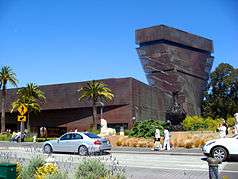

Named for M. H. de Young, the San Francisco newspaper magnate, the De Young Museum is a fine arts museum that was opened in January 1921. Its original building, the Fine Arts Building, was part of the 1894 Midwinter Exposition, of which Mr. de Young was the director. The Fine Arts Building featured several artists, twenty-eight of whom were female. One of these revolutionaries was Helen Hyde, who is featured in the De Young Museum today. Once the fair ended, the Egyptian-styled building remained open "brimful and running over with art." Most of these pieces were paintings and sculptures purchased by De Young himself, and others were donations of household antiques from the older community, which were "more sentimental than artistic." By 1916, the Fine Arts Building’s collection had grown to 1,000,000 items, and a more suitable museum was necessary.[4]
Construction to build a new museum began in 1917. With funds donated by De Young, and Louis Mullgardt as head architect, the De Young Museum was completed in 1921 in a "sixteenth century Spanish Renaissance design, with pale salmon colored façades that were burdened with rococo ornamentation." At its center was a 134-foot tower from which its wings extended. At the entrance was the Pool of Enchantment, which consisted of the sculptured Indian boys created by M. Earl Cummings. The museum contained four wings: the East Wing (featuring ever-changing paintings, sculptures and photography by artists such as Vincent Van Gogh); the Central Wing (famous American and European work); the Northeast wing (Asian collections); and the West Wing (artistic history of San Francisco).[9]
The original De Young Memorial Museum stood for most of the twentieth century, until 2001 when it was completely rebuilt, reopening in 2005. The head-architects, Jacques Herzog and Pierre de Meuron, when asked on their design, said they wanted to create a place "where the art would be less hierarchically presented – more like contemporary art than like bijoux." [10] The building is mostly constructed of copper, and its unique design was created with the idea that the "building would be enhanced not only by sunlight but also by San Francisco’s constant fog." [10] Since the opening of the De Young in 1921, its galleries have mostly changed, but some of the art originally featured during the fair and in the early twentieth century still exists in the museum today. The galleries of Asian art have since been relocated, but the De Young still features American art, Modern art, African art, textiles and sculptures, and special alternating exhibitions.
Academy of Sciences

The California Academy of Sciences was founded in 1853, just three years after California was made a state, making it the oldest scientific institution in the western United States. Evolutionist Charles Darwin corresponded on the initial organization of the early institution.[11] The original museum consisted of eleven buildings built between 1916 and 1976 located on the former site of the 1894 Midwinter Fair’s Mechanical Arts Building in Golden Gate Park.[12] The structure was largely destroyed in the 1989 earthquake and just three original buildings were conserved for the new construction: the African Hall, the North American Hall, and the Steinhart Aquarium.[12] The new building opened in 2008 at the same location in the park. The present building encompasses 37,000 square meters[12] and includes exhibits of natural history, aquatic life, astronomy, gems and minerals, and earthquakes.[13] The museum is currently one of the ten largest natural history museums in the world and holds 18 million scientific specimens between the research institute and public exhibits.[13]
The academy also contains a 2.5-acre living roof with almost 1.7 million native California plants[14] and domes that cover the planetarium and rainforest exhibitions. The soil of the roof is six inches deep, which reduces storm water runoff by more than 90%[14] and naturally cools the interior of the museum, thereby reducing the need for air-conditioning. The glass panels of the living roof also contain cells that collect more than 5% of the electricity needed to power the museum.[12] Due to its eco-friendly materials and natural sources of energy, the California Academy of Sciences has been named the country’s only LEED-platinum certified museum, granted by the U.S. Green Building Council.[14]
Japanese Tea Garden
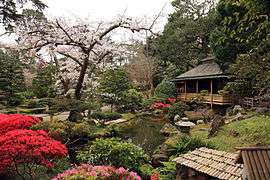
The Japanese Tea Garden is the oldest public Japanese garden in the United States and takes up five of the 1,017 acres (412 ha) of the Golden Gate Park.[15] George Turner Marsh, an Australian immigrant, originally created the garden for the 1894 Midwinter Exposition. The landscaping and design was maintained by Makoto Hagiwara until 1942 and includes still-standing features such as the Drum Bridge and the Tea House.[16] Subsequent additions include a pagoda and Zen garden. It is located to the left of the de Young Museum and is one reported site of the introduction of the fortune cookie to America.[17] The Japanese Tea Garden serves as a spot of tranquility in the middle of the various activities that take place at the Golden Gate Park[18] and provides visitors "a place in which it is possible to be at one with nature, its rhythms, and changing beauties."[19] The Japanese Tea Garden brings in more than $1 million to the Golden Gate Park and the city annually. There is a constant debate deciding between what changes should and should not be made to the garden. On one hand, adding souvenir shops and a diversity of food options at the garden brings in more money to the organization monitoring the Golden Gate Park, the Recreation and Park Commission. On the other hand, selling products that share knowledge about Japanese gardens and the Japanese culture help keep the Japanese Tea Garden authentic.[20]
Structures and Buildings
Conservatory of Flowers
History
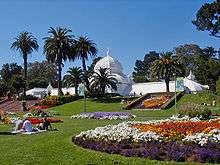
The Conservatory of Flowers opened in 1879, standing today as the oldest building in Golden Gate Park.[21] The Conservatory of Flowers is one of the world's largest conservatories, as well as one of few large Victorian greenhouses in the United States.[22] Built of traditional wood and glass panes, the Conservatory stands at 12,000 square feet[23] and houses 1,700 species of tropical, rare and aquatic plants.[21] Though it wasn’t originally constructed, William Hammond Hall included the idea of a conservatory in his original concept for the design of the park.[22] The idea was later realized with the help of twenty-seven of the wealthiest business owners in San Francisco.[23] The conservatory was originally prefabricated for local real estate entrepreneur James Lick for his Santa Clara, California, estate but was still in its crates when he died in 1876. Those 27 business owners purchased the conservatory and donated it to the city, it was erected in Golden Gate Park and opened to the public in 1879.
Restoration and Reconstruction
In 1883, a boiler exploded and the main dome caught fire. A restoration was undertaken by Southern Pacific magnate Charles Crocker. It survived the earthquake of 1906, only to suffer another fire in 1918. In 1933 it was declared unsound and closed to the public, only to be reopened in 1946. In 1995, after a severe storm with 100 mph (161 km/h) winds damaged the structure, shattering 40% of the glass, the conservatory had to be closed again. It was cautiously dissected for repairs and finally reopened in September 2003.
Rooms within the Conservatory
Special Exhibits Room
Every six months the special exhibits room changes its gallery. Oftentimes the exhibits include model trains as well as models displaying the topic of presentation. Galleries vary from California fairs to tropical island survival.
Potted Plants Gallery
The Potted Plant room holds various unusual plants. The pots and urns that hold the plants were created by various artists from around the world.[4] This room is maintained at hotter temperatures to accommodate the needs of the plants. The Potted Plant Gallery follows Victorian architecture and the 19th century idea of displaying tropical plants in non-tropical parts of the world.[4]
Lowlands Gallery

The Lowlands Gallery contains plants from the tropics of South America (near the equator).[9] This room also contains plants that produce more well-known products such as bananas, coffee, and cinnamon.[9] The room is usually kept around 70 °F with a very high level of humidity through the use of a frequent system of misters, as the Lowland Tropics typically get 100-400 inches of rain each year and are located in elevations from 3,000 feet to sea level.[9]
Highlands Gallery
The Highlands Gallery contains native plants from South to Central America.[14] Its plants collect moisture from the air, and from water that drips from the trees above. Due to its drastically higher elevation (3,000-10,000 feet), this room is kept cooler than the Lowlands Gallery (around 65 °F) and is kept at a very high level of humidity through the use of a misting system, as the Highland Tropics typically receive 200 inches of rain per year.[14]
Aquatics Gallery
The Aquatic Plants room is similar in conditions as those near the Amazon River.[24] As such, many carnivorous plants that thrive in hot, humid environments grow throughout the room. The soil is mostly lacking in nutrients and the carnivorous plants are kept very moist by condensation of the water in the extremely humid air.[24] The room also contains 2 large ponds, one holding 9,000 gallons of water, and the other holding half as much.[24] Both ponds are kept at 83 °F and are maintained using beneficial bacteria, filters, water heaters, and solutions to prevent algae buildup.[24]
Beach Chalet
The two-story Beach Chalet[25] faces the Great Highway and Ocean Beach at the far western end of the park. It was opened in 1925 in Spanish clonial revival style as a city-run restaurant and included changing rooms for beach visitors.[26] Elaborate murals were added to the first floor as a 1936 Works Progress Administration project. The murals depict real people and scenes from San Francisco in the 1930s. After World War II the city leased the Beach Chalet to the Veterans of Foreign Wars for $50 a month.[27] A 1952 "smoker" featured gambling, strippers and lewd films, arrested in connection, was Salvatore (Tarbaby) Terrano, of the Waxey Gordon narcotics ring.[27] The VFW moved out after the city bumped the rent to $500 a month in 1979.[27] The Mural room is now the San Francisco Visitor's Center. After several years of closure and following a renovation completed in 1996, the building now houses the Beach Chalet Brewery and Restaurant on the second floor, opened by Lara and Gar Truppelli and Timon Malloy. Its sister restaurant, the Park Chalet, is located to the back of the Beach Chalet with a dining room facing the park and outdoor dining on a terrace and lawn area.
Windmills
Before the construction of the windmills, Golden Gate Park was paying the Spring Valley Water Works up to 40 cents per 1000 gallons of water.[28] To avoid this expense the North (Dutch) Windmill was commissioned in 1902 when Superintendent John McLaren deemed the Park's pumping plant insufficient to supply the additional water essential to the life of the Park. A survey and inspection of the vast area west of Strawberry Hill revealed a large flow of water toward the ocean. The North windmill was constructed to reclaim the drainage towards the Pacific Ocean and direct fresh well water back into the park.[28] Alpheus Bull Jr., a prominent San Franciscan, designed the North Windmill. The Fulton Engineering Company received the bid for the ironwork, and Pope and Talbot Lumber Company donated sails ("spars") of Oregon pine. The North Windmill was installed, standing 75 feet tall with 102 foot long sails. The Windmill pumps water up an elevation of 200 feet with a capacity of 30,000 gallons of water per pump per hour, supplying and replenishing Lloyd Lake, Metson Lake, Spreckels Lake and Lincoln Park.[29] The water is pumped from the valley into a reservoir on Strawberry Hill from there the water runs downhill into Falls and Stow Lake.[30] The North Windmill was successful causing another system of wells and a second windmill at the southwestern corner of the Park to be recommended. Samuel G Murphy provided from his own means, $20,000 to erect the windmill. The South Windmill (Murphy Windmill) stands as the largest in the world, having the longest sails in the world, since its construction, with the ability to lift 40,000 gallons of water per hour.

Statues
The Statue of John McLaren stands in the Rhododendron Dell. John McLaren had this statue hidden and it was only placed in the dell after his death.[31] Other Statues of historical figures are also located throughout the park, including Francis Scott Key, Robert Emmet, Robert Burns, the double monument to Johann Goethe and Friedrich Schiller, General Pershing, Beethoven, Giuseppe Verdi, President Garfield, and Thomas Starr King. The bronze statue of Don Quixote and his companion, Sancho Panza kneeling to honor their creator, Cervantes, combines historical and fictitious characters. At the Horseshoe Court in the northeast corner of the park near Fulton and Stanyan, there is a concrete bas-relief of "The Horseshoe Pitcher" by Jesse "Vet" Anderson, a member of the Horseshoe Club. Across from the Conservatory of Flowers is Douglas Tilden's "The Baseball Player". On the hill at the top of Rainbow Falls stands the Prayerbook Cross, a 60-foot tall monument erected in 1894. A gift from the Church of England, the Celtic-style cross once was quite prominent, but is now largely hidden by park trees.[32]
Carousel

An ornate carousel displaying a bestiary is housed in a circular building near the children's playground. The carousel was built in 1914 by the Herschell-Spillman Company.[33] The building was occupied by three previous carousels before the current attraction was purchased by Herbert Fleishhacker from the Golden Gate International Exposition in 1941. The 1914 carousel has undergone several major renovations, the first, a transition from steam to electric power with the assistance of the PG&E Company.[34] In 1977 the carousel closed for safety concerns and The San Francisco Arts Commission hired local artist Ruby Newman to oversee the artistic restoration. Her crew of craftspeople restored the badly deteriorated carousel and she hand painted all animals, chariots, and decorative housing (she holds the copyright). The carousel was re-opened in 1984.[35] Presently, the carousel includes sixty two animals, a German Band Organ, and painted landscapes of the bay area by Ruby Newman. Two of the animals, a goat and an outside stander horse, are by the Dentzel Wooden Carousel Company.[36]
Encompassing the carousel is the Koret Playground, originally the Children's Quarters, which was envisioned to be a primary feature in the Golden Gate Park's beginnings. Funded by Senator William Sharon, the park was finished in 1888, and designated a recreational space for women and their children.[37] At the time, the park boasted to be the first public children's playground in America; offering swings, indoor enclosures, open sitting areas and the original carousel to community youth.[38] The 2007 renovations funded by the Koret foundation nurtured the playground to its current height for the use of park goers.
Natural Features
San Francisco Botanical Garden at Strybing Arboretum

The San Francisco Botanical Garden was laid out in the 1890s, but funding was insufficient until Helene Strybing willed funds in 1926. Planting began in 1937 with WPA funds supplemented by local donations. This 55 acres (22 ha) arboretum contains more than 7,500 plant species.[39] The arboretum also houses the Helen Crocker Russell Library, northern California's largest horticultural library.[40]
Due to the unique climate of San Francisco and Golden Gate Park,[41] the plants in the San Francisco Botanical Garden range from a variety of different national origins, some of them no longer existing in their natural habitats. Areas of origin include but are not limited to Africa, Australia, New Zealand, and Central and South America.[42] These regions of origin go from desert to tropical. In addition, some native California species are housed in the garden as well, such as Redwood trees.[43] Overall, the tradition of these diverse gardens that eventually served to inspire the San Francisco Botanical Garden comes originally from China, Europe, and Mexico.[44]
Stow Lake / Strawberry Hill
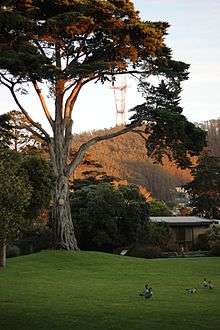

Stow Lake surrounds the prominent Strawberry Hill, now an island with an electrically pumped waterfall. Rowboats and pedalboats can be rented at the boathouse. Much of the western portion of San Francisco can be seen from the top of this hill, which at its top contains one of the reservoirs that supply a network of high-pressure water mains that exclusively supply specialized fire hydrants throughout the city.
Two bridges connect the inner island to the surrounding mainland.
Spreckels Lake / Model Boat Facility
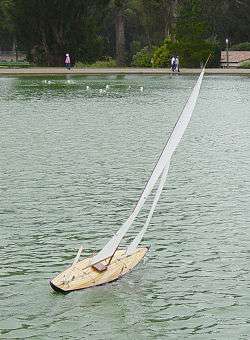
An artificial reservoir behind a small earthen dam that lies on the north side of the Golden Gate Park between Spreckels Lake Drive and Fulton Street to the north, and John F. Kennedy Drive to the south and named after sugar-fortune heir and then San Francisco Parks Commissioner Adolph B. Spreckels,[45] who donated the surrounding land to the park. Built between 1902 and 1904 at the request of the San Francisco Model Yacht Club specifically as a model boating facility, the lake was first filled in February 1904 and opened March 20, 1904. One can usually find both 'sail driven,' self-guided Yachts and electric or gas/nitro powered radio-controlled model boats of many types and designs plying the lake's waters most times of year.
Chain of Lakes
Many naturalistically landscaped lakes are placed throughout the park: several are linked together into chains, with pumped water creating flowing creeks. Out of the original 14 natural marshy lakes within the sand dunes Golden Gate Park was built in, only 5 remain, three of which are the Chain of Lakes. The three lakes, North, Middle, and South Lake, are located along the Chain of Lakes Drive.
North Lake
North Lake is the largest of the three, and is known for its water birds that often live on the small islands within the lake.[46] Some of the birds spotted are egrets, belted kingfishers, ducks, and great blue herons. It is surrounded by a paved walkway that is often used by families, joggers, and dog walkers.[47]
In 1898, McLaren started a landscaping project, inspired by Andrew Jackson Downing’s teachings on building with nature. Seven islands were planted within the North Lake in 1899, using different species of shrubs and trees. A gazebo was built, and wooden footbridges were used to connect the different islands within the lake. Both the gazebo and the bridges were removed in order to conserve nesting birds on the islands.[48]
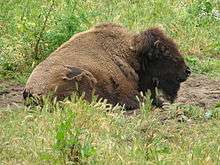
Middle Lake
Middle Lake is particularly known for bird-watching due to the visits of migrant species of birds like tanagers, warblers and vireos. It is surrounded by a dirt trail and vegetation.[47] The lake resembles the marshes that existed before Golden Gate Park, and is known for being a more remote and romantic setting.[46]
South Lake
South Lake is the smallest of the three lakes, and borders Martin Luther King Jr. Drive.[46] There are few birds, and few visitors.[47]
Bison Paddock
Bison (Bison bison) have been kept in Golden Gate Park since 1891, when a small herd was purchased by the park commission.[49] At the time, the animal's population in North America had dwindled to an all-time low, and San Francisco made a successful effort to breed them in captivity. In 1899, the paddock in the western section of the park was created. At its peak and through a successful captive breeding program, more than 100 calves were produced at Golden Gate Park, helping preserve the iconic bison population numbers in North America, which has been critical to the culture and livelihood of Native Americans.
In 1984, Mayor Dianne Feinstein's husband, Richard C. Blum, purchased a new herd as a birthday present for his wife.[50] The older bison in the paddock today are descendants of those animals.
In December 2011, after the number of bison in the paddock had dwindled to three, Assemblywoman Fiona Ma’s office led another preservation effort. With donations from the Theodore Rosen Charitable Foundation, Richard C. Blum, and the Garen Wimer Ranch, Assemblywoman Ma’s office worked with the San Francisco Zoo and SF Recreation and Parks to add seven new bison to the existing herd. The Paddock is currently open to the public for viewing.
Hippie Hill
Nestled in the trees between the Conservatory of Flowers and Haight street, Hippie Hill is a home to what can be described as San Francisco’s "alternative" lifestyles. The area known as Hippie Hill is a small hill with a sloping green lawn just off of Kezar Drive, with Eucalyptus and Oak on either side.[51] The hill is a place where people from many different backgrounds come together. "It’s ultra liberal San Francisco at its’ finest."[52]
Hippie Hill has also been part of San Francisco’s history, namely the Summer of Love, which was a large counterculture movement that partially took part on the hill. During this Summer of Love, people gathered together to connect with one another in many ways, mainly dropping acid and playing music together. Music has its own history on the hill, with musicians and bands like Janis Joplin, the Grateful Dead, Jefferson Airplane, and George Harrison playing music for free to the public. Improvised drum circles still form on the weekends where people come together and fill the park with a constant beat for hours on end. The hill played a major part in the hippies' ability to openly use drugs because the police had employed a policy of looking the other way when it came to the hill.[13]
Though the police have been known to crack down on certain occurrences in the park, when it comes to Hippie Hill, the SFPD has been known to be lenient with what goes on there. This leniency seems to increase during things like concerts and other public events. As supervisor London Breed stated, "smoking anything in any city park is illegal, but San Francisco has a tradition of turning a blind eye to infractions for official or unofficial events."[13] The police department has stated that they are not naïve enough to attempt to catch all the people smoking marijuana at the hill, but as Police Chief Greg Suhr said, "There are plenty of other things that came with it that we will not have."[53]
Wild animals
In 2013, San Francisco photographer David Cruz first sighted and shot pictures of coyote pups in Golden Gate Park.[54] It is estimated that over 1000 coyotes live in San Francisco, and there have been more sightings in Golden Gate Park than any other spot in the city.[55] Coyotes have proven adaptive in the city, as they live primarily in open prairies and deserts.[56]
Dedicated areas and memorials
National AIDS Memorial Grove
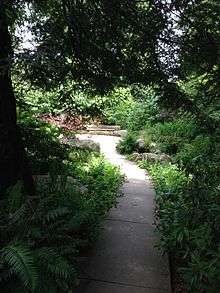
In the decades following the first reports of AIDS in the United States in 1981, Americans were overwhelmed with the devastation of the AIDS epidemic.[57] In 1988 a few San Francisco residents belonging to communities hit hard by the AIDS epidemic envisioned a place of remembrance for those who had lost their lives to AIDS. They imagined a serene AIDS memorial where people could go to heal.[58] Renovation for the National Aids Memorial Grove began in September 1991 and continues today as communities are constantly working to improve it.[59] Located at 856 Stanyan Street, in the eastern portion of Golden Gate Park, the Grove stretches across seven acres of land. In 1996, due to Nancy Pelosi’s efforts, the "National AIDS Memorial Grove Act" was passed by Congress and the President of the United States, Bill Clinton, which officially made those seven acres of Golden Gate Park the first AIDS memorial in the United States. Then in 1999, it earned the Rudy Bruner Silver Medal Award for excellence in the urban environment.[59]
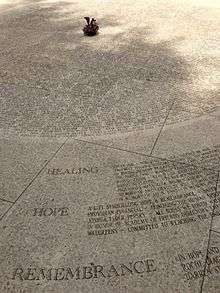
Due to its serene environment of redwoods, maples, ferns, benches, logs, and boulders, this memorial remains a place where people go to grieve, hope, heal, and remember.[12] Located at the Dogwood Crescent the Circle of Friends is the heart of the grove.[60] The Circle of Friends has over 1,500 names inscribed on its flagstone ground which represent lives lost to AIDS.[61] If one wishes to inscribe a name into the Circle of Friends they must donate $1,000 to the memorial and the name will be inscribed before the Worlds AIDS day commemoration on December 1.[62] Funded privately and tended by over 500 of volunteers, The National AIDS Memorial Grove remains an important sanctuary for remembrance.[63]
On November 30 an annual Light in the Grove fundraising gala is held in the Grove. This event, held on the eve of Worlds Aids Day, sells out each year and was voted "Best Bay Area LGBT Fundraiser" by Bay Area Reporter readers in 2015.[64]
Shakespeare Garden
The Shakespeare Garden is a relatively small "17th century classical garden"[65] located directly southwest of the California Academy of Sciences. It is a tribute to William Shakespeare and his works, decorated with flowers and plants that are mentioned in his plays. The entrance is an ornate metal gate that says "Shakespeare Garden" intertwined with vines. Directly past the entrance is a walkway overarched with trees and lined with small flowers and a sundial in the center. The main area has a large moss tree and benches. At the end of the garden there is a wooden padlocked shelf containing a bust of William Shakespeare himself. The cast was made and given to the garden by George Bullock in 1918 and has remained behind locked doors since around 1950 to prevent people from cutting off pieces of the statue to melt down.[66] Around the bust, there are four plaques, originally six, with quotes from Shakespeare. The missing two were stolen and most likely sold and melted down so the thieves could make a profit from the bronze the plaques were made from.[65]
Alice Eastwood, the director of botany from the California Academy of Sciences at the time, came up with the idea for the garden in 1928. It however is not unique, as there are several Shakespeare gardens around the world, including "Cleveland, Manhattan, Vienna, and Johannesburg."[65] The garden is a popular spot for weddings.[67] There are over 200 plants from Shakespeare’s works.[66]
Rose Garden
The Rose Garden is found between John F. Kennedy Drive and Park Presidio Drive.[68]
Sports and Recreation
Golden Gate park contains many areas for sports and recreation including tennis courts, soccer fields, baseball fields, lawn bowling fields, an angling and casting club, a golf course, horseshoe pits, an archery range, the polo field, and Kezar Stadium. Golden Gate park formed the first Lawn Bowling Club in the United States in 1901, with an Edwardian style clubhouse constructed in 1915.[69]
Kezar Stadium
Kezar Stadium was built between 1922 and 1925 in the southeast corner of the park. It hosted various athletic competitions and was the home stadium of the San Francisco 49ers of the AAFC and NFL from 1946 to 1970. It also hosted the Oakland Raiders of the AFL for one season in 1960.

The old 59,000-seat stadium was demolished in 1989 and replaced with a modern 9,044-seat stadium, which includes a replica of the original concrete arch at the entryway.
The stadium has been used in recent years for soccer, lacrosse, and track and field. The stadium also holds the annual city high school football championship, the Turkey Bowl. The Turkey Bowl dates back to 1924 and is played each Thanksgiving. The game was held at Lowell High School in 2014 because Kezar was closed due to renovation of the running track. Galileo High School has the most overall wins in the game (16) after breaking Lincoln High School's record four-game winning streak in 2009.[70][71]
The stadium also hosts the football game in the three-part Bruce-Mahoney Trophy competition between Sacred Heart Cathedral Preparatory and Saint Ignatius College Preparatory, two Catholic high schools in San Francisco, in addition to serving as the home field for Sacred Heart Cathedral's football program.
The Polo Field
The sport of polo came to California in 1876, when the California Polo Club was established with help of Bay Area native, Captain Nell Mowry.[72] By the late 1800s, polo in San Francisco was dominated by the Golden Gate Driving Club and the San Francisco Driving Club. In 1906, the Golden Gate Park Stadium was built by private subscription from the driving clubs[73] which contained both a polo field[74] and a cycling velodrome.[75] Later on, the stadium was renamed simply the Polo Field. In the mid 1930s, the City and County of San Francisco used PWA and WPA funds to renovate the polo field.[72] In 1939, additional WPA funds were used to build polo sheds, replacing already-standing horse stables.[73] Polo continued being played through the 1940s[76] but by the 1950s polo stopped being played on the Polo Field because the sport had largely migrated to other bay area cities where land more suitable for polo was available.[74] In 1985 and 1986, polo was brought back to the Polo Field in Golden Gate Park for the second[77] and third annual San Francisco Grand Prix and Equestrian Festival.[74] Today, polo is not regularly played on the Polo Field, but from 2006 to 2010 Polo in the Park was hosted annually.[78]

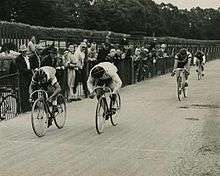
The Polo Fields has a history of cycling lasting from 1906 to the 21st century. The Polo Fields were originally created for track cycling in 1906, as track cycling was a popular sport in the early 1900s.[79] Despite a down-surge of popularity in the mid-1900s, track cycling has seen a huge rebirth ever since the introduction of more track cycling programs in the Olympics in 2003.[80] San Francisco has seen a surge in cycling popularity, and groups such as "Friends of the Polo Field Cycling Track" have recently formed.[81]
The field has an extensive history with music and events. Because of the location and size of the Polo Fields, various events are commonly held on the field. Historically, many major music festivals took place in the park, including the Human Be-In, which featured bands like the Grateful Dead and the Jefferson Airplanes.[82] More contemporary music festivals such as the Outside Lands and Hardly Strictly Bluegrass also take place on or nearby the Polo Fields.[83] One of the largest public gatherings in San Francisco took place in the Polo Fields—a public Rosary in 1961 with 550,000 people.[84] Public political events were also held at the field, such as the anti-Vietnam War rally in 1969 and the Tibetan Freedom Concert in 1996.[85]
Now in the 21st century, the Polo Field is split into two divisions: the inner soccer field, and the flat-style cycling velodrome found around the field itself. Today many sports are played in the polo fields, including soccer, cross country running, and various types of cycling. The cycling track is still alive, with a large amount of time-trial races held every cycling season.[86] Recently a cyclist in 2013 has set a record in the park by riding a total of 188.5 miles on the Polo Field velodrome, circling it 279 times for a total of 10 hours moving.[87]
Archery Range
Archery was first organized in Golden Gate Park in 1881.[12] However, there was not a devoted range specifically for archery until around 1933. In 1936, during Franklin D. Roosevelt’s presidency, many parts of Golden Gate Park, including the archery range, were improved as part of the Works Progress Administration (WPA).[88] With WPA support, the archery range was increased in size and the adjacent hill was carved to serve as a backdrop for stray arrows. Bales of hay are used as targets and are provided by the Golden Gate Joad Archery Club as well as donations from other donors.[89] The Golden Gate Park Archery Range is located right inside the park off of 47th Street and Fulton Street. It is open whenever the park itself is open and is free to use by anyone. There is no staff and equipment is not offered to be rented at the range, however there are archery stores nearby for rentals and there are multiple groups that offer training and lessons.
Golden Gate Park Nursery
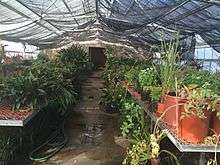

Established in 1870, the Golden Gate Park Nursery has remained one of the few places in the park restricted to the public. This nursery began with donated plants from around the world and expanded over the years with the care of past Golden Gate Park gardeners.[90] The nursery has moved around the park thrice; first to where McLaren Lodge stands today, then to where Kezar Stadium is currently located and finally to its current location of Martin Luther King Jr. Drive.[91] This Nursery houses over 800 species of plants, some of which are exclusive to the nursery, and are sold to the public on the third Saturday of the month.[92] Every week over 3,000 plants are dispersed within the city and park.[4] When the park requires repairing or is in need of empty beds filled, the Nursery provides its wide variety of plants to fill in the blank spaces. Indoors, the plants are set up in neat rows and beds, showing off the nursery’s green diversity for the buyers picking. The Golden Gate Park Nursery is one of the city’s main green providers and is greatly responsible for the city’s plant life.
Homeless camps
The City of San Francisco has grappled with what to do about camps of homeless people living in Golden Gate Park, which have been criticized as unsanitary, and "demoralizing" for park users and workers.[93] The camps have been described by journalists as full of garbage, broken glass, hypodermic needles, and human excrement, and the people in them are described as suffering from serious addictions and often behaving aggressively with police and park gardeners.[94][95][96] There have been occasional incidents of violence against homeless people in the park, including the 2010 park beating to death of a homeless man and an attack on park visitors by dogs owned by a park resident, also in 2010.[97] In the 1990s, then-Mayor Willie Brown sought unsuccessfully to borrow the Oakland Police Department's helicopters in order to find homeless people's camps.[98]
Starting in 1988 under then-mayor Art Agnos, and continuing under the direction of subsequent mayors including Frank Jordan, Willie Brown, and Gavin Newsom, San Francisco police have conducted intermittent sweeps of the park aimed at eliminating the camps.[99][100] Tactics have included information campaigns designed to inform homeless residents about city services available to help them; waking sleeping homeless people and making them leave the park; issuing citations for infractions and misdemeanors such as camping, trespassing, or public intoxication, which carry penalties of $75 to $100;[101] and the seizure and removal from the park of homeless people's possessions. During the night, police urge people in Golden Gate Park to be careful around homeless people. They have been known to become belligerent or protective of their 'usual spots' at night.
The crackdowns have been criticized by anti-poverty activists and civil liberties groups, who say they attack only the symptoms of homelessness while ignoring its root causes, and criminalize the poor for their poverty while ignoring their property rights and constitutional rights.[102][103] In 2006, the American Civil Liberties Union brought a lawsuit against the city government on behalf of 10 homeless people, alleging property violations by the city during sweeps in Golden Gate Park the year before.[104]
Golden Gate Park in Popular Culture
The tradition of large, free public gatherings in the park continues to the present, especially at Hellman Hollow. Originally named Speedway Meadow, it was renamed in 2011 in honor of Warren Hellman.[105] In 2001, Hellman founded the Hardly Strictly Bluegrass Festival (formerly the "Strictly Bluegrass Festival"), a free music festival held in October. Hellman Hollow also plays host to a number of large-scale events such as the 911 Power to the Peaceful Festival held by musician and filmmaker Michael Franti with Guerrilla Management. Since the parks conception, over 5,000 concerts have been held in the park. A book, titled Five Thousand Concerts in the Park lists and describes the park's long history with music.[106]
At Golden Gate Park is a live recording of the concert given on May 7, 1969 by the Jefferson Airplane at Golden Gate Park in San Francisco.
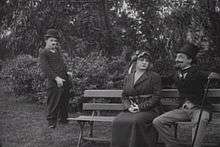
Charlie Chaplin filmed scenes in the park for at least two movies, including A Jitney Elopement[107] and In the Park,[108] both from 1915. A scene in Orson Welles' The Lady from Shanghai was shot in the Steinhart Aquarium in the old California Academy of Sciences building, and the Conservatory of Flowers was filmed in Harold and Maude.
Dirty Harry scenes were filmed in Kezar Stadium.[109]
In Star Trek IV: The Voyage Home, a Klingon Bird-of-Prey is said to land in the park, but the scene was actually filmed at Will Rogers State Historic Park near Los Angeles.[110]
A scene from The Pursuit of Happyness was shot in the Children's Playground.
Scaramouche (1952) includes scenes of duels looking west into the fog at Speedway Meadows, and interiors in De Young Museum's old period rooms.
In The Lineup (1958), scenes were shot inside the Steinhart Aquarium.[111]
The Bugs Bunny cartoon Bushy Hare (1950): Bugs pops up in Golden Gate Park with Lloyd Lake Portals to the Past, the remains of the A.E. Towne mansion from the 1906 Earthquake.
In the TV Series Eli Stone, in the episode "Waiting for that Day", some citizens of San Francisco seek refuge in the park during a 6.8 earthquake. They later witness the destruction of the Golden Gate Bridge from the park, though in reality, the bridge isn't visible from the park.
The opening scene of the 1978 version of Invasion of the Bodysnatchers was filmed on the outskirts of Golden Gate Park.
The film "The Diary Of A Teenage Girl" filmed its opening scene in Golden Gate Park.[112]
In the film Time After Time, Malcolm McDowell can be seen exiting the park near 6th avenue in the Richmond District.[113]
The film, Adventures of Robin Hood (1938) features the Golden Gate Park as the location of Sherwood Forest.[114]
Gallery
See also
References
- 1 2 "The Most Visited City Parks in the U.S.". The Trust for Public Land. 2011. Retrieved January 26, 2014.
- ↑ National Park Service (2009-03-13). "National Register Information System". National Register of Historic Places. National Park Service.
- ↑ San Francisco Board of Park Commissioners (1875), Third Biennial Report of the San Francisco Park Commissioners, San Francisco: Edward Bosqqui & Co., p. 55
- 1 2 3 4 5 Wilson, Katherine (1950). Golden Gate: The Park of a Thousand Vistas. Caldwell, Idaho: The Caxton Printers. pp. 52–58.
- ↑ John L. Levinsohn, "Frank Morrison Pixley of The Argonaut," The Book club of San Francisco, 1989.
- ↑ "Queen Wilhelmina Tulip Garden". Golden Gate Park.com. Retrieved January 28, 2015.
- ↑ "CITY WITHIN A CITY: HISTORIC CONTEXT STATEMENT FOR SAN FRANCISCO'S MISSION DISTRICT" (PDF). City and County of San Francisco Planning Department. November 2007.
- ↑ "Groundwater". San Francisco Public Utilities Commission. 2011.
- 1 2 3 4 Work Projects, Administration (1947). San Francisco. New York, New York: Hastings House Publishing. pp. 338–342.
- 1 2 Petalson, Ruth (2010). Architect: The Work of the Pritzker Prize Laureates in Their Own Words. New York, New York: Black Dog and Leventhal Publishers. pp. 118–121.
- ↑ Pollock, Christopher (2001). San Francisco's Golden Gate Park. Portland, Oregon: Graphic Arts Center Publishing Company. pp. 59–61.
- 1 2 3 4 5 6 "Renzo Piano Building Workshop - Projects - By Type - California Academy of Sciences". www.rpbw.com. Retrieved 2015-11-24.
- 1 2 3 4 "California Academy of Sciences Museum". www.u-s-history.com. Retrieved 2015-11-24.
- 1 2 3 4 5 "Designing Our Future: Sustainable Landscapes". www.asla.org. Retrieved 2015-11-24.
- ↑ "Golden Gate Park Guide | San Francisco Recreation and Park". sfrecpark.org. Retrieved 2015-11-24.
- ↑ Brown, Kendall H. (1998). Rashômo : The Multiple Histories of the Japanese Tea Garden at Golden Gate Park. Studies in the History of Gardens & Designed Landscapes.
- ↑ "Commission tells bidders for lease to focus on authenticity-S.F. wants more of Japan in Tea Garden". San Francisco Chronicle Section: Metro Page: A1. October 16, 2008.
- ↑ "Japanese Tea Garden { About Us }". japaneseteagardensf.com. Retrieved 2015-11-24.
- ↑ Keane, Marc P. (1996). Japanese Garden Design. Rutland, VT: Tuttle Publishing. pp. "Maintenance".
- ↑ Bowman, Becky (January 20, 2006). "San Francisco-Both bids for Japanese Tea Garden are rejected-Commission calls for fresh round of bidding for stands". San Francisco Chronicle Section. p. BAY AREA B5.
- 1 2 "Conservatory of Flowers | San Francisco Recreation and Park". sfrecpark.org. Retrieved 2015-11-30.
- 1 2 "Golden Gate Park Conservatory of Flowers | World Monuments Fund". www.wmf.org. Retrieved 2015-11-30.
- 1 2 "Conservatory of Flowers | San Francisco Parks Alliance". www.sfparksalliance.org. Retrieved 2015-11-30.
- 1 2 3 4 "Aquatics Gallery" (PDF). Conservatory of Flowers. July 2014.
- ↑ "Beach Chalet". SF Rec & Park. Retrieved January 25, 2015.
- ↑ Harry J. Johnson (November 13, 2009). "The Beach Chalet". Artamble. Retrieved January 6, 2011.
- 1 2 3 Carroll, Jerry (December 26, 1996). "Tide Turns for the Beach Chalet". SF Gate. San Francisco. Retrieved January 25, 2015.
- 1 2 Pamphlets on Silviculture. 1912-01-01.
- ↑ "Windmill Power for Golden Gate Park - 1914". www.sfmuseum.org. Retrieved 2015-12-02. line feed character in
|title=at position 32 (help) - ↑ "Windmill Power for Golden Gate Park - 1914". www.sfmuseum.org. Retrieved 2015-12-02. line feed character in
|title=at position 32 (help) - ↑ Out, Time (2011-01-01). Time Out San Francisco. Time Out Guides. ISBN 9781846702204.
- ↑ "Prayerbook Cross". Golden Gate Park.com. Retrieved January 28, 2015.
- ↑ "Golden Gate Park Carousel". Golden Gate Park.com. Retrieved January 15, 2015.
- ↑ "Koret Playground & Carousel | San Francisco Recreation and Park". sfrecpark.org. Retrieved 2015-12-02.
- ↑ "Ruby Newman Fine Arts Studio". www.rubynewman.com. Retrieved 2015-12-02.
- ↑ "National Carousel Association - Census of Classic Wood Carousels (Condensed)". carousels.org. Retrieved 2015-12-02.
- ↑ Olmsted, Frederick. The Papers of Frederick Law Olmsted: The Last Great Projects, 1890-1895.
- ↑ Accardi, Catherine (2012-01-01). San Francisco Landmarks. Arcadia Publishing. ISBN 9780738595801.
- ↑ McKechnie, Michael (April 2009). "Collection". San Francisco Botanical Garden. Retrieved March 4, 2013.
- ↑ "Helen Crocker Russell Library of Horticulture". San Francisco Botanical Garden. Archived from the original on October 27, 2007. Retrieved January 6, 2011.
- ↑ "About- San Francisco Botanical Garden". San Francisco Botanical Garden. Retrieved 15 November 2015.
- ↑ Hession, Stephanie (23 September 2015). "A World of Plants at San Francisco Botanical Garden". SF Gate. Retrieved 15 November 2015.
- ↑ Edwards, Nick (2012). The Rough Guide to San Francisco and the Bay Area. Rough Guides.
- ↑ Hill, Arthur (February 1915). "History and Functions of Botanical Gardens". Annals of the Missouri Botanical Garden. doi:10.2307/2990033. JSTOR 2990033.
- ↑ "Adolph B. Spreckels". Press Reference Library (Southwest Edition): Notables of the Southwest. The Los Angeles Examiner. Los Angeles. 1912. p. 341. OCLC 365099589. Retrieved January 6, 2011.
- 1 2 3 "Golden Gate Park Lakes". Golden Gate Park. Retrieved 2015-11-24.
- 1 2 3 "Chain of Lakes | San Francisco Recreation and Park". sfrecpark.org. Retrieved 2015-11-24.
- ↑ Katz, Erica (2001). San Francisco's Golden Gate Park: A Thousand and Seventeen Acres of Stories. Portland, Oregon: Westwiinds Press. ISBN 978-1558685451.
- ↑ Gardner, David (September 16, 2003). "Bison Paddock". Lightight Photography. Archived from the original on 2007-11-22. Retrieved January 5, 2011.
- ↑ Morain, Dan (June 24, 1991). "Where Buffalo Roam : Bison, With Names Like King Lear and Lady Macbeth, Have Home in Golden Gate Park". Los Angeles Times. Retrieved January 28, 2015.
- ↑ Anthony, Gene (1995-01-01). The Summer of Love: Haight-Ashbury at Its Highest. John Libbey Eurotext. ISBN 9780867194210.
- ↑ "SF Oddities: Hippie Hill". Lenzbreakr's Weblog. Retrieved 2015-11-19.
- ↑ "'Hippie Hill' Crackdown Expected At SF's Golden Gate Park, 4/20 Festivities". Retrieved 2015-11-19.
- ↑ Logout, $USERNAME Desktop Notifications Profile Settings. "PHOTOS: Adorable Coyote Pups In San Francisco!". The Huffington Post. Retrieved 2015-12-03.
- ↑ "San Francisco's Latest Fortune-Hunters: The Coyotes of Golden Gate Park | Hoodline". hoodline.com. Retrieved 2015-12-03.
- ↑ "Coyotes, Coyote Pictures, Coyote Facts - National Geographic". National Geographic. Retrieved 2015-12-03.
- ↑ Valdiserri, Ronald (2011). "Thirty Years Of AIDS in America: A Story of Infinite Hope".
- ↑ "AIDS Memorial Grove". Golden Gate Park. Retrieved 2015-11-19.
- 1 2 "About The Grove". National AIDS Memorial Grove in San Francisco. Retrieved 2015-11-19.
- ↑ "AIDS Memorial Grove". AIDS memorial. Retrieved 2015-11-19.
- ↑ Heather Knight (November 29, 2011). "National AIDS grove has 20th anniversary". SFGate. Retrieved 2015-11-19.
- ↑ "Circle of Friends". National AIDS Memorial Grove in San Francisco. Retrieved 2015-11-19.
- ↑ Heather Knight (November 29, 2011). "National AIDS grove has 20th anniversary". SFGate. Retrieved 2015-11-19.
- ↑ "San Francisco: "Light in the Grove" - San Francisco Bay Events". franciscobay.events. Retrieved 2015-12-07.
- 1 2 3 "An Afternoon with the Bard in Golden Gate Park". kalw.org. Retrieved 2015-12-02.
- 1 2 "Garden of Shakespeare's Flowers". Golden Gate Park. Retrieved 2015-11-19.
- ↑ "Golden Gate Park – Shakespeare Garden | San Francisco Recreation and Park". sfrecpark.org. Retrieved 2015-11-19.
- ↑ https://goldengatepark.com/rose-garden.html
- ↑ "13 Things You Probably Didn't Know About Golden Gate Park". thrillist. Retrieved 2015-12-03.
- ↑ Drumwright, Steve (November 27, 2008). "Turkey Day game to decide San Francisco high school football champion". The San Francisco Examiner.
- ↑ Winegarner, Beth (November 26, 2009). "Galileo defeats Lincoln 35-0". The San Francisco Examiner. Retrieved January 25, 2015.
- 1 2 Starr, Kevin. The Dream Endures: California Enters the 1940s. New York: Oxford UP, 1997. Print.
- 1 2 Kipen, David. San Francisco in the 1930s: The WPA Guide to the City by the Bay. Berkeley: U of California, 2011. Print.
- 1 2 3 "Polo and Horse Show in Golden Gate Park." Sunset Sept. 1986: 55. Print
- ↑ "License to Race: Cycling on the Golden Gate Park Polo Field 1930s–1950s | http://www.flysfo.com/". www.flysfo.com. Retrieved 2015-11-19. External link in
|title=(help) - ↑ San Francisco, the Bay and Its Cities. New York: Hastings House, 1947. Print.
- ↑ "Equestrian Festival At the Polo Fields - Local Sports." The San Francisco Chronicle 3 Aug. 1985, Final, Sports: 48. NewsBank. Web. 19 Nov. 2015.
- ↑ "Polo in the Park". Polo in the Park. Retrieved 2015-11-19.
- ↑ "Exhibitions | http://www.flysfo.com/". www.flysfo.com. Retrieved 2015-11-24. External link in
|title=(help) - ↑ "CYCLING: History of Cycling Track at the Olympic Games" (PDF). olympic.org. International Olympic Committee.
- ↑ "About The Friends". Friends of the Polo Field Cycling Track. Retrieved 2015-11-24.
- ↑ Lawson, Kristan; Rufus, Anneli (2013-09-24). California Babylon. St. Martin's Griffin. ISBN 9781466854147.
- ↑ "Hardly Strictly Bluegrass 13 - Fri Oct 4, Sat Oct 5, & Sun Oct 6, 2013". www.hardlystrictlybluegrass.com. Retrieved 2015-11-24.
- ↑ "St. Paul Street Evangelization – San Francisco, CA". St. Paul Street Evangelization – San Francisco, CA. Retrieved 2015-11-24.
- ↑ "From Freeing Tibet to Rebooting Judaism - Q&A". The Forward. Retrieved 2015-11-24.
- ↑ "Polo Field Smack Down". Polo Field Smack Down. Retrieved 2015-11-24.
- ↑ Moyer, Fred (2013-06-30). "Polo Fields 300k". Strava.com. Strava, Inc.
- ↑ "W.P.A. Construction in San Francisco (1935-1942) - FoundSF". foundsf.org. Retrieved 2015-11-24.
- ↑ "Where We Teach Archery – Golden Gate Park Archery Range | Golden Gate Junior Olympic Archery Development". www.goldengatejoad.com. Retrieved 2015-11-24.
- ↑ Pollock, Chris (2001). San Francisco's Golden Gate Park: A Thousand and Seventeen Acres of Stories. Portland, Or: WestWinds. p. 89.
- ↑ Schenker, Heath (January 2011). "Golden Gate Park: Views from the Thicket".
- ↑ Wilson, Katherine (1950). Golden Gate: The Park of a Thousand Vistas. Caldwell, ID: Caston Printers. pp. 89, 90.
- ↑ Levy, Dan (August 24, 1995). "Campers Get 3 Days to Vacate Golden Gate Park / Mayor reveals homeless sweep plan". San Francisco Chronicle. Retrieved September 11, 2011.
- ↑ Garcia, Ken (May 6, 2010). "Ken Garcia: Homeless in Golden Gate Park: An old story that never ends". The San Francisco Examiner. Retrieved January 25, 2015.
- ↑ Buchanan, Wyatt (July 29, 2007). "the Situation at Golden Gate Park". SF Gate. Retrieved January 6, 2011.
- ↑ Nevius, C.W. (September 23, 2007). "Golden Gate Park update – fewer needles, homeless campsites". San Francisco Chronicle. Retrieved September 11, 2011.
- ↑ Aldax, Mike (September 2, 2010). "Crackdown on midnight mayhem". The San Francisco Examiner. Retrieved January 25, 2015.
- ↑ Roschelle, Anne; Wright, Talmadge (2003). Hall, Tim; Miles, Malcolm, eds. Urban Futures: Critical Commentaries on Shaping Cities. Routledge. p. 156.
- ↑ Vega, Cecilia, Heather Knight (September 29, 2006). "SAN FRANCISCO / Crackdown in Golden Gate Park / Few homeless leave on deadline; city wants to offer help, services". San Francisco Chronicle. Retrieved September 11, 2011.
- ↑ Marinucci, Carla, Alex Barnum, Jaxon Van Derbeken (November 7, 1997). "Brown Intensifies Hard-Line Tactics to Rid Park of Encampments / Nighttime copter checks ordered". San Francisco Chronicle. Retrieved September 11, 2011.
- ↑ Kelkar, Kamala (November 5, 2009). "Golden Gate Park homeless ignore outreach efforts". The San Francisco Examiner. Retrieved September 11, 2011.
- ↑ Wilson, Yumi (June 18, 1998). "Homeless Sue S.F. Over Golden Gate Park Sweeps". San Francisco Chronicle. Retrieved September 11, 2011.
- ↑ Curtius, Mary (December 1, 1997). "Brown Joins Push to Retake, Restore Golden Gate Park". Los Angeles Times. Retrieved September 11, 2011.
- ↑ "Homeless People Sue San Francisco for Property Rights Violations" (Press release). ACLU of Northern California. June 17, 2006. Archived from the original on February 14, 2012. Retrieved January 5, 2011.
- ↑ "Warren Hellman honored with Golden Gate Park meadow renaming". The San Francisco Chronicle. December 15, 2011.
- ↑ Five Thousand Concerts in the Park: The History of the Golden Gate Park Band. Blurb. 2010-01-01. ISBN 9780978997953.
- ↑ "A Jitney Elopement". Film in America. Retrieved January 28, 2015.
- ↑ "In The Park". Film in America. Retrieved January 28, 2015.
- ↑ Turbow, Jason (January 12, 2012). "West Coast Brew Gave Kezar Stadium Its Color". New York Times. Retrieved February 3, 2015.
- ↑ Gordon, William A. (1995). Shot on this site : a traveler's guide to the places and locations used to film famous movies and television shows. Secaucus, NJ: Carol Publishing Group. p. 40. ISBN 9780806516479. Retrieved February 3, 2015.
- ↑ "The Lineup - Filming Locations". IMDb. Retrieved February 4, 2015.
- ↑ Edelstein, David. "On Screen, 'Diary Of A Teenage Girl' Packs The Punch Of A Good Graphic Novel". NPR.org. Retrieved 2015-12-03.
- ↑ "Time After Time (1979)". IMDb. Retrieved 2015-12-03.
- ↑ Gordon, William (1995). Shot on This Site: A Traveler's Guide to the Places and Locations Used to Film Famous Movies and TV Shows. 120 Enterprise Avenue, Secaucus, N.J. 07094: Carol Publishing Group. p. 40. ISBN 0-8065-1647-X.
External links
| Wikimedia Commons has media related to Golden Gate Park. |
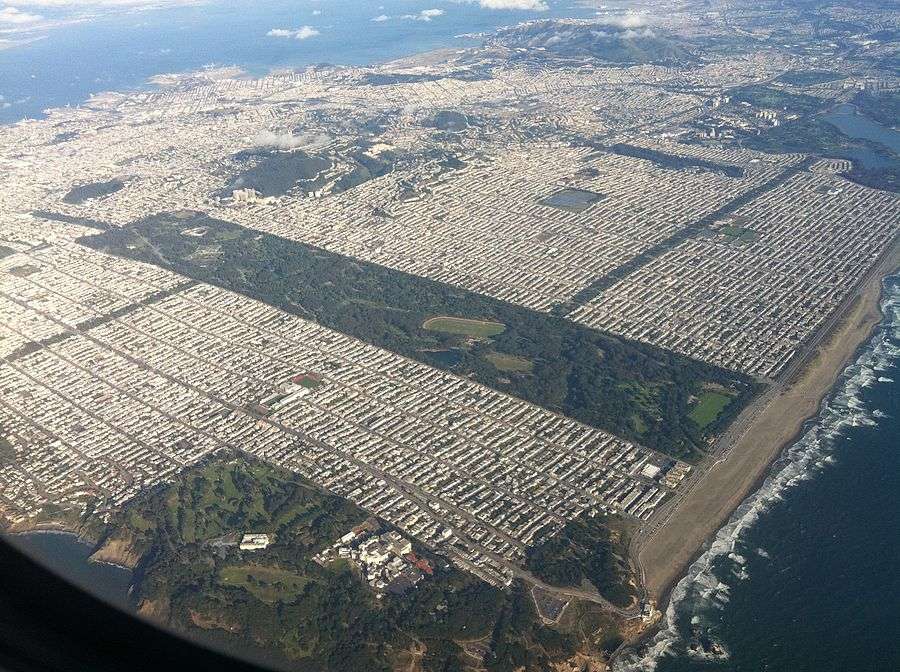




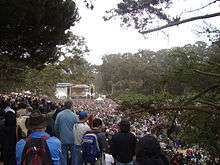







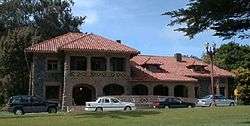
.svg.png)